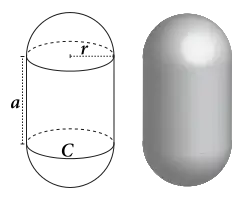Capsule (geometry)
A capsule (from Latin capsula, "small box or chest"), or stadium of revolution, is a basic three-dimensional geometric shape consisting of a cylinder with hemispherical ends.[1] Another name for this shape is spherocylinder.[2][3][4][5]

It can also be referred to as an oval although the sides (either vertical or horizontal) are straight parallel.
Usages
The shape is used for some objects like containers for pressurised gases, windows of places like a jet, software buttons, building domes (like the U.S. Capitol, having the windows of the top hat that depict The Apotheosis of Washington inside designed with the appearance of the shape & placed in an omnidirectional pattern), mirrors, and pharmaceutical capsules.
In chemistry and physics, this shape is used as a basic model for non-spherical particles. It appears, in particular as a model for the molecules in liquid crystals[6][3][4] or for the particles in granular matter.[5][7][8]
Formulas
The volume of a capsule is calculated by adding the volume of a ball of radius (that accounts for the two hemispheres) to the volume of the cylindrical part. Hence, if the cylinder has height ,
- .
The surface area of a capsule of radius whose cylinder part has height is .
Generalization
A capsule can be equivalently described as the Minkowski sum of a ball of radius with a line segment of length .[5] By this description, capsules can be straightforwardly generalized as Minkowski sums of a ball with a polyhedron. The resulting shape is called a spheropolyhedron.[7][8]
Related shapes
A capsule is the three-dimensional shape obtained by revolving the two-dimensional stadium around the line of symmetry that bisects the semicircles.
References
- Sarkar, Dipankar; Halas, N. J. (1997). "General vector basis function solution of Maxwell's equations". Physical Review E. 56 (1, part B): 1102–1112. doi:10.1103/PhysRevE.56.1102. MR 1459098.
- Kihara, Taro (1951). "The Second Virial Coefficient of Non-Spherical Molecules". Journal of the Physical Society of Japan. 6 (5): 289–296. doi:10.1143/JPSJ.6.289.
- Frenkel, Daan (September 10, 1987). "Onsager's spherocylinders revisited". Journal of Physical Chemistry. 91 (19): 4912–4916. doi:10.1021/j100303a008. hdl:1874/8823. S2CID 96013495.
- Dzubiella, Joachim; Schmidt, Matthias; Löwen, Hartmut (2000). "Topological defects in nematic droplets of hard spherocylinders". Physical Review E. 62 (4): 5081–5091. arXiv:cond-mat/9906388. Bibcode:2000PhRvE..62.5081D. doi:10.1103/PhysRevE.62.5081. PMID 11089056. S2CID 31381033.
- Pournin, Lionel; Weber, Mats; Tsukahara, Michel; Ferrez, Jean-Albert; Ramaioli, Marco; Liebling, Thomas M. (2005). "Three-dimensional distinct element simulation of spherocylinder crystallization". Granular Matter. 7 (2–3): 119–126. doi:10.1007/s10035-004-0188-4.
- Onsager, Lars (May 1949). "The effects of shape on the interaction of colloidal particles". Annals of the New York Academy of Sciences. 51 (4): 627–659. doi:10.1111/j.1749-6632.1949.tb27296.x. S2CID 84562683.
- Pournin, Lionel; Liebling, Thomas M. (2005). "A generalization of Distinct Element Method to tridimensional particles with complex shapes". Powders and Grains 2005 Proceedings vol. II. A.A. Balkema, Rotterdam. pp. 1375–1378.
- Pournin, Lionel; Liebling, Thomas M. (2009). "From spheres to spheropolyhedra: generalized Distinct Element Methodology and algorithm analysis". In Cook, William; Lovász, László; Vygen, Jens (eds.). Research Trends in Combinatorial Optimization. Springer, Berlin. pp. 347–363. doi:10.1007/978-3-540-76796-1_16. ISBN 978-3-540-76795-4.